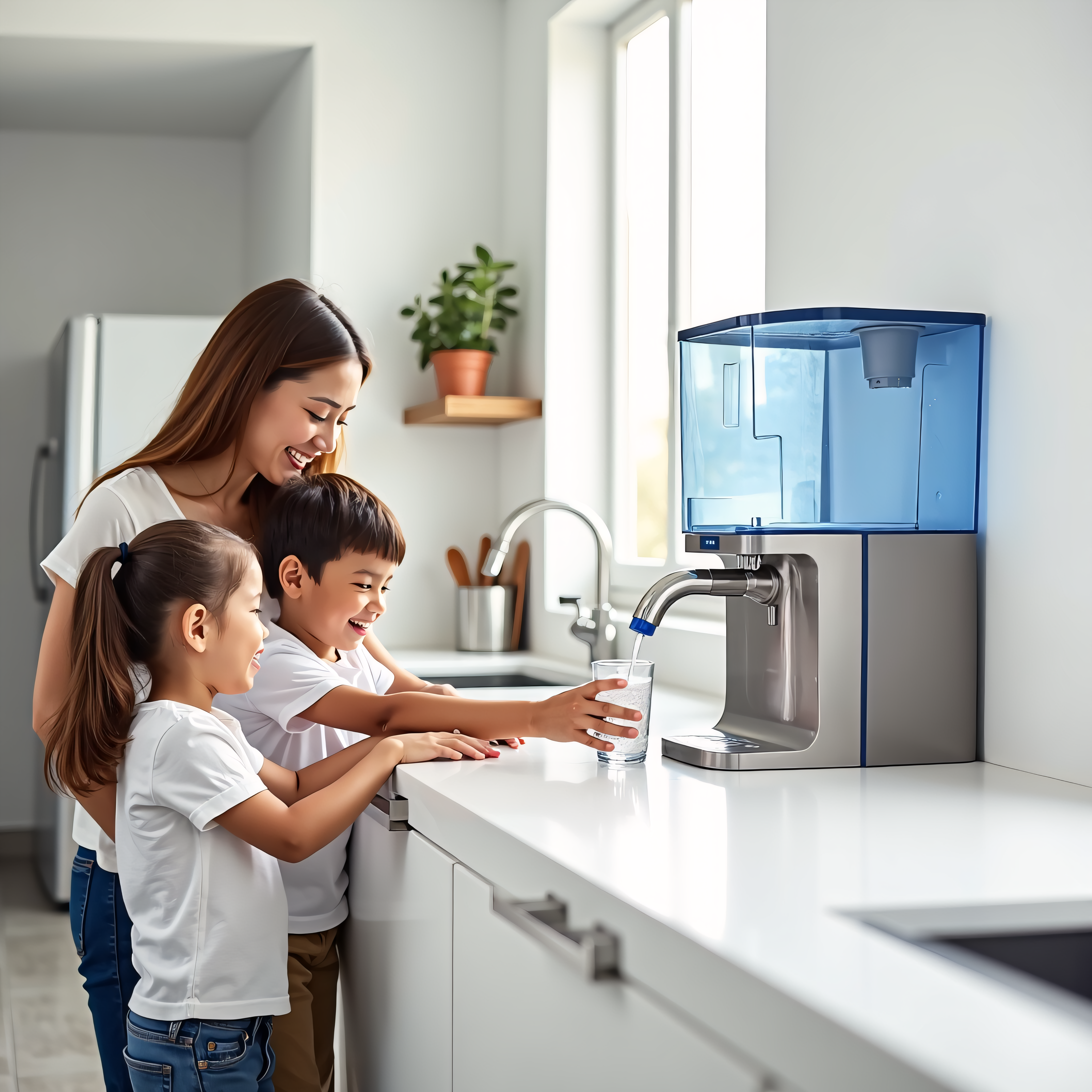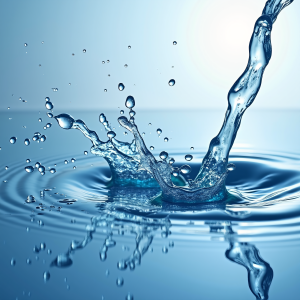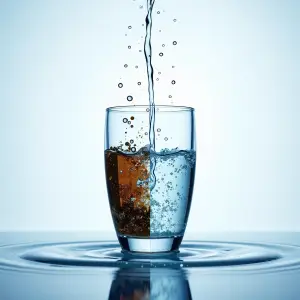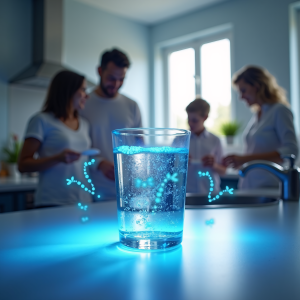estimated reading time: 10 minutes
Did you know that approximately 37.7 million Indians suffer from waterborne diseases annually? (CGWB). In a country where access to truly clean drinking water remains a significant challenge, safeguarding your family’s health has never been more critical. Common contaminants like lead, arsenic, fluoride, along with harmful bacteria and viruses, lurk in water sources across India, posing serious health risks. This is where Aquaguard steps in.
For decades, Aquaguard has been a trusted name in water purification, pioneering innovative technologies to deliver safe, clean, and healthy drinking water to millions of Indian households. Starting as a revolutionary concept in 1984, Aquaguard quickly became synonymous with reliable water purification, consistently evolving to address the ever-changing water quality challenges faced across the country. Today, they stand as a market leader, committed to providing cutting-edge solutions for a healthier tomorrow.
Aquaguard’s extensive product range caters to diverse needs, offering solutions based on different purification technologies. From the efficiency of Aquaguard RO (Reverse Osmosis) systems that eliminate dissolved impurities to the effectiveness of UV purification in tackling harmful microorganisms, and the benefits of Ultrafiltration (UF) and mineral-based purification – there’s an Aquaguard purifier designed for your specific water source and lifestyle.
This comprehensive guide will dive deep into the world of Aquaguard, providing you with all the information you need to make an informed decision. We’ll explore the science behind the different purification technologies, offer a detailed overview of popular Aquaguard models like the Sure, Nova, Neo, Infinity, and Essence, break down pricing, explain filter types and replacement schedules, cover installation and service procedures, and direct you to resources for expert customer care. Ultimately, our goal is to empower you to choose the perfect Aquaguard water purifier to protect your family’s well-being.
Understanding Aquaguard Water Purification Technologies & Finding the Right System for You
Did you know that approximately 37.7 million Indians suffer from waterborne diseases annually? (CGWB). In a country where access to truly clean drinking water remains a significant challenge, safeguarding your family’s health has never been more critical. Common contaminants like lead, arsenic, fluoride, along with harmful bacteria and viruses, lurk in water sources across India, posing serious health risks. This is where Aquaguard steps in.
For decades, Aquaguard has been a trusted name in water purification, pioneering innovative technologies to deliver safe, clean, and healthy drinking water to millions of Indian households. Starting as a revolutionary concept in 1984, Aquaguard quickly became synonymous with reliable water purification, consistently evolving to address the ever-changing water quality challenges faced across the country. Today, they stand as a market leader, committed to providing cutting-edge solutions for a healthier tomorrow.
Aquaguard’s extensive product range caters to diverse needs, offering solutions based on different purification technologies. Understanding these technologies is key to choosing the right system. Here’s a breakdown of the core methods Aquaguard employs:
Reverse Osmosis (RO)
Considered the gold standard for comprehensive purification, Aquaguard RO systems force water through a semi-permeable membrane. This membrane effectively removes dissolved impurities like salts, heavy metals (lead, arsenic), fluoride, and even microscopic contaminants. RO is particularly effective for water sources with high Total Dissolved Solids (TDS). However, RO systems can sometimes remove beneficial minerals, which is why many Aquaguard RO purifiers include a remineralization stage.
Ultrafiltration (UF)
UF utilizes a membrane with slightly larger pores than RO. This allows it to remove bacteria, viruses, and cysts while retaining essential minerals. UF is ideal for water sources with low to moderate TDS and is a good option if you primarily want to eliminate biological contaminants. It doesn’t require electricity, making it a more energy-efficient choice.
Ultraviolet (UV) Purification
UV purification uses ultraviolet light to kill bacteria, viruses, and other microorganisms. It’s a highly effective disinfection method but doesn’t remove dissolved impurities or sediment. UV purification is often used as a final stage in RO or UF systems to ensure complete microbiological safety.
Mineralization Technology
Recognizing the importance of essential minerals for health, Aquaguard incorporates mineralization technology into many of its purifiers. This process adds back beneficial minerals like calcium and magnesium to the purified water, enhancing its taste and nutritional value.
Exploring Popular Aquaguard Models
Aquaguard offers a diverse range of models, each tailored to specific needs and water conditions. Here’s a glimpse at some popular options:
- Aquaguard Sure: Often an entry-level option, the Sure series typically utilizes UF technology, making it suitable for water sources with low TDS. It’s a cost-effective solution for basic purification needs.
- Aquaguard Neo: The Neo range often combines RO and UF technologies, providing a more comprehensive purification process. These models are suitable for water sources with moderate TDS and offer a good balance of purification and mineral retention.
- Aquaguard Marvel: Marvel models frequently feature advanced RO technology with a higher TDS rejection rate, making them ideal for highly contaminated water sources. They often include features like a TDS adjuster to customize the mineral content of the purified water.
- Aquaguard Ritz: Positioned as a premium offering, the Ritz series often incorporates advanced features like smart alerts, automatic filter flush, and enhanced remineralization technology.
- Aquaguard Delight: Delight models are designed for aesthetic appeal and often feature sleek designs and advanced purification capabilities, combining RO, UF, and UV technologies.
-
Aquaguard Blaze: Aquaguard Blaze Insta is a premium water purifier offering 9-stage RO+UV+Active Copper purification with instant hot water at 80°C and dual dispense for ambient water. Dual stainless steel tanks, a taste adjuster, and water-saving features make it ideal for modern kitchens.
Source: https://cgwb.gov.in/
Filter Replacement & Maintenance: Ensuring Continued Purity
Regular filter replacement is crucial for maintaining the effectiveness of your Aquaguard purifier. Filter lifespans vary depending on the model and water quality, but here’s a general guideline:
- Pre-Filter: Typically replaced every 3-6 months to remove sediment and prolong the life of other filters.
- Sediment Filter: Replaced every 6-12 months to remove particulate matter.
- Carbon Filter: Replaced every 6-12 months to remove chlorine, taste, and odor.
- RO Membrane: Replaced every 12-24 months, depending on water quality and usage.
- UF Membrane: Replaced every 12-24 months.
Aquaguard provides clear instructions for filter replacement, and replacement filters are readily available through their service network and online retailers. Maintaining your water filtration system with regular upkeep will preserve the quality of water produced.
Aquaguard FAQs: Your Water Purification Questions Answered
Q1: What exactly *is* Aquaguard and how does it differ from other water purifiers?
Aquaguard is a leading brand in water purification systems in India, known for its innovative technology. Unlike basic RO water purifiers, many Aquaguard models utilize technologies like UF, TDS adjusters, and even UV disinfection. This means Aquaguard can effectively purify diverse water sources – from municipal taps to borewells – delivering consistently safe drinking water tailored to your specific needs and water quality.
Q2: Is an Aquaguard RO purifier necessary even if my water *looks* clean?
Visible clarity doesn’t guarantee potable water. Many harmful contaminants like bacteria, viruses, dissolved salts (TDS), and heavy metals are invisible to the naked eye. An Aquaguard RO system effectively removes these, providing truly pure water for consumption. Investing in purification is crucial for long-term health, even with seemingly clean water sources.
Q3: How often do I need to change the Aquaguard filter cartridges, and what happens if I don’t?
Aquaguard filter replacement frequency varies by model and water quality, typically every 6-12 months. Neglecting filter changes reduces purification efficiency, allowing contaminants to pass through. This impacts the quality of water and can even damage the purifier itself. Regular maintenance ensures optimal performance and continued water safety.
Q4: What is TDS, and why is TDS adjustment important in an Aquaguard purifier?
TDS (Total Dissolved Solids) refers to the concentration of minerals, salts, and metals in water. While some minerals are essential, excessive TDS can affect taste and potentially be harmful. Many Aquaguard purifiers feature TDS adjusters, allowing you to customize the mineral content, providing balanced and healthy drinking water suitable for all ages.
Q5: My Aquaguard purifier is making a lot of noise – what could be the problem?
Excessive noise in your Aquaguard water purifier often indicates low water pressure, a clogged filter, or air trapped within the system. Check the water supply and filter cartridges first. If the issue persists, contacting Aquaguard customer service or a qualified technician is recommended to diagnose and resolve the problem, ensuring optimal water purifier function.
Q6: Are Aquaguard purifiers expensive to run, considering electricity and filter costs?
While there’s an initial investment, Aquaguard RO systems are relatively energy-efficient. Modern models consume minimal electricity. The primary running cost is filter replacement, but this is a small price to pay for consistent access to safe drinking water and avoiding potential health issues associated with contaminated water.
Conclusion: Prioritizing Purity – Your Path to Cleaner Water
We’ve journeyed through the critical importance of water purification, exploring the diverse contaminants that can impact our health and the various technologies designed to combat them. From the fundamental role of sediment filters in removing particulate matter to the sophisticated capabilities of reverse osmosis and UV sterilization, understanding these processes empowers you to make informed decisions about your family’s well-being. We’ve highlighted that no single solution is universally perfect; the ideal system depends heavily on your water source, local contaminants, and individual needs. Considering factors like TDS levels, bacterial presence, and the potential for chemical pollutants is paramount.
Ultimately, investing in a quality water purification system isn’t just about removing impurities – it’s about investing in preventative health and peace of mind. While specific brands and models fluctuate in availability and features, the core principles remain constant: assess your water quality, understand the technologies, and choose a system that effectively addresses your unique requirements.
As technology continues to advance, we can anticipate even more efficient and targeted purification methods. Nanotechnology and advanced membrane filtration are emerging areas with the potential to revolutionize water treatment, offering even greater contaminant removal and reduced energy consumption. Staying informed about these developments will be key to ensuring you have access to the best possible water purification solutions.
Ready take next step cleaner, healthier water? Browse expertly curated selection top-rated water purifiers take advantage of exclusive discounts! Check out our blog post on Kent, Aquaguard , Gravity filters and Livpure Or, still unsure of filter system right you, check out our blogs on A Comprehensive Guide to Water Purification



